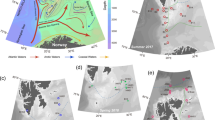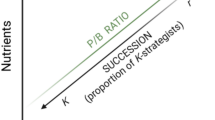Abstract
Nearly 20%–50% of the annual terrestrial dissolved organic carbon (DOC) from the Huanghe (Yellow) River was transported to the estuary during the 5–14 d of water and sediment regulation. The concentration of DOC increased sharply during the period of water and sediment regulation, which may promote the terrestrial DOC consumption by heterotrophic bacterioplankton. Water and sediment regulation provides an ideal condition for the study of terrestrial DOC consumption by heterotrophic bacterioplankton when terrestrial DOC increases sharply in rainy season, which may help to seek the fates of terrestrial DOC in the estuaries and coasts. In this study, the concentration and stable isotope of DOC, the biomass, growth, and respiration of heterotrophic bacterioplankton were determined. By the study, we found both average percent contribution of terrestrial DOC to the DOC pool and Contribution of terrestrial DOC to the carbon composition of heterotrophic bacterioplankton decreased as distance from the river mouth increased offshore, which was deceased from (39.2±4.0)%, (37.5±4.3)% to (30.3±3.9)%, (28.2±3.9)% respectively. 255–184 μg C/(L d) terrestrial DOC was consumed by heterotrophic bacterioplankton. And 29%–45% terrestrial DOC consumed by heterotrophic bacterioplankton releasing as CO2 by respiration. Comparing with tropical estuary, terrestrial DOC consumed by heterotrophic bacterioplankton was lower in temperate estuary (this study). Temperature may limit the consumption of terrestrial DOC by heterotrophic bacterioplankton.
Similar content being viewed by others
References
Abrantes K G, Barnett A, Bouillon S. 2013. Stable isotope-based community metrics as a tool to identify patterns in food web structure in east African estuaries. Functional Ecology, 28(1): 270–282.
Abrantes K G, Sheaves M. 2010. Importance of freshwater flow in terrestrial-aquatic energetic connectivity in intermittently connected estuaries of tropical Australia. Marine Biology, 157(9): 2071–2086.
Abrantes K, Sheaves M. 2008. Incorporation of terrestrial wetland material into aquatic food webs in a tropical estuarine wetland. Estuarine, Coastal and Shelf Science, 80(3): 401–412.
Asmala E, Autio R, Kaartokallio H, Pitkänen L, Stedmon C A, Thomas D N. 2013. Bioavailability of riverine dissolved organic matter in three Baltic Sea estuaries and the effect of catchment land use. Biogeosciences, 10(11): 6969–6986
Atwood T B, Wiegner T N, MacKenzie R A. 2012. Effects of hydrological forcing on the structure of a tropical estuarine food web. Oikos, 121(2): 277–289.
Bai J, Li K R, Li Z Y, Sun J, Wei H, Liu S M, Wu Z M. 2003. Relationship between the environmental factors and distribution of bacterioplankton in the Bohai Sea. Journal of Ocean University of Qingdao, 33(6): 841–846. (in Chinese with English abstract)
Carlson C A, Ducklow H W. 1996. Growth of bacterioplankton and consumption of dissolved organic carbon in the Sargasso Sea. Aquatic Microbial Ecology, 10: 69–85.
Coffin R B, Fry B, Peterson B J, Wright R T. 1989. Carbon isotopic compositions of estuarine bacteria. Limnology and Oceanography, 34(7): 1305–1310.
Coffin R B, Velinsky D J, Devereux R, Price W A, Cifuentes L A. 1990. Stable carbon isotope analysis of nucleic acids to trace sources of dissolved substrates used by estuarine bacteria. Applied and Environmental Microbiology, 56(7): 2012–2020.
Gattuso J P, Frankignoulle M, Wollast R. 1998. Carbon and carbonate metabolism in coastal aquatic ecosystems. Annual Review of Ecology and Systematics, 29: 405–434.
Hedges J I, Keil R G, Benner R. 1997. What happens to terrestrial organic matter in the ocean? Organic Geochemistry, 27(5–6): 195–212.
Hitchcock J N, Mitrovic S M, Hadwen W L, Growns I O, Rohlfs A M. 2016a. Zooplankton responses to freshwater inflows and organic-matter pulses in a wave-dominated estuary. Marine and Freshwater Research, 67(9): 1374–1386.
Hitchcock J N, Mitrovic S M, Hadwen W L, Roelke D L, Growns I O, Rohlfs A M. 2016b. Terrestrial dissolved organic carbon subsidizes estuarine zooplankton: an in situ mesocosm study. Limnology and Oceanography, 61(1): 254–267.
Hitchcock J N, Mitrovic S M. 2015. After the flood: changing dissolved organic carbon bioavailability and bacterial growth following inflows to estuaries. Biogeochemistry, 124(1–3): 219–233.
Hitchman M L, 1978. Measurement of Dissolved Oxygen. Wiley, New York. 255p.
Hou R, Bai J, Liu X S, Gao H W, Zhao Y G. 2015. Response of heterotrophic bacterioplankton growth to exogenous nutrients in southern of South China Sea. Periodical of Ocean University of China, 45(10): 103–108. (in Chinese with English abstract)
Jansson M, Hickler T, Jonsson A, Karlsson J. 2008. Links between terrestrial primary production and bacterial production and respiration in lakes in a climate gradient in subarctic Sweden. Ecosystems, 11(3): 367–376.
Kaldy J E, Cifuentes L A, Brock D. 2005. Using stable isotope analyses to assess carbon dynamics in a shallow subtropical estuary. Estuaries and Coasts, 28(1): 86–95.
Karlsson J, Jansson M, Jonsson A. 2007. Respiration of allochthonous organic carbon in unproductive forest lakes determined by the Keeling plot method. Limnology and Oceanography, 52(2): 603–608.
Laruelle G G, Dürr H H, Slomp C P, Borges AV. 2010. Evaluation of sinks and sources of CO2 in the global coastal ocean using a spatially-explicit typology of estuaries and continental shelves. Geophysical Research Letters, 37(15): L15607.
Liu Z Y, Zhang L J, Cai W J, Wang L, Xue M, Zhang X S. 2014. Removal of dissolved inorganic carbon in the Yellow River Estuary. Limnology and Oceanography, 59(2): 413–426.
Liu Z Y. 2014. Carbon Transport and Flux in the Yellow River Estuary. Ocean University of China, Qingdao, China. p. 47–66. (in Chinese with English abstract)
Mayorga A, Aufdenkampe A K, Masiello C A, Krusche A V, Hedges J I, Quay P D, Richey J E, Brown T A. 2005. Young organic matter as a source of carbon dioxide outgassing from Amazonian rivers. Nature, 436(7050): 538–541.
McCallister S L, Bauer J E, Cherrier J E, Ducklow H W. 2004. Assessing sources and ages of organic matter supporting river and estuarine bacterial production: a multiple-isotope (Δ14C, δ13C, and δ15N) approach. Limnology and Oceanography, 49(5): 1687–1702.
McCallister S L, Del Giorgio P A. 2008. Direct measurement of the δ13C signature of carbon respired by bacteria in lakes: linkages to potential carbon sources, ecosystem baseline metabolism, and CO2 fluxes. Limnology and Oceanography, 53(4): 1204–1216.
Mead L H, Wiegner T N. 2010. Surface water metabolism potential in a tropical estuary, Hilo Bay, Hawaii, USA, during storm and non-storm conditions. Estuaries and Coasts, 33(5): 1099–1112.
Middelburg J J, Nieuwenhuize J. 1998. Carbon and nitrogen stable isotopes in suspended matter and sediments from the Schelde Estuary. Marine Chemistry, 60(3–4): 217–225.
Moran M A, Hodson R E. 1994. Support of bacterioplankton production by dissolved humic substances from three marine environments. Marine Ecology Progress Series, 110(2–3): 241–247.
Moran M A, Sheldon W M, Sheldon J E. 1999. Biodegradation of riverine dissolved organic carbon in five estuaries of the southeastern United States. Estuaries and Coasts, 22(1): 55–64.
Pollard P C, Ducklow H. 2011. Ultrahigh bacterial production in a eutrophic subtropical Australian river: does viral lysis short-circuit the microbial loop? Limnology and Oceanography, 56(3): 1115–1129.
Raymond P A, Bauer J E. 2000. Bacterial consumption of DOC during transport through a temperate estuary. Aquatic Microbial Ecology, 22: 1–12.
Raymond P A, Bauer J E. 2001. Riverine export of aged terrestrial organic matter to the North Atlantic Ocean. Nature, 409(6819): 497–500.
Schlesinger W H, Melack J M. 1981. Transport of organic carbon in the world’s rivers. Tellus, 33(2): 172–187.
Smith E M, Kemp W M. 2003. Planktonic and bacterial respiration along an estuarine gradient: responses to carbon and nutrient enrichment. Aquatic Microbial Ecology, 30: 251–261.
Sun T, Shen X M, Liu F F, Ma L K, Xu J, Pang A P. 2011. Effects of freshwater inflows on net ecosystem productivity in the Yellow River Estuary. Acta Scientiae Circumstantiae, 31(6): 1311–1319. (in Chinese with English abstract)
Wang J. 2013. The Spatial and Temporal Distribution of Virioplankton and Correlation with Heterotrophic Bacteria in the Bohai Sea. Ocean University of China, Qingdao, China. p. 15–38. (in Chinese with English abstract)
Wang M, Zhang L J, Gui Z S. 2011. Spatial and temporal transport of organic carbon in Changjiang mainstream and influence of three gorges project. Periodical of Ocean University of China, 41(1–2): 117–124. (in Chinese with English abstract)
Wu L X, Zhao M, Li J W, He W J. 2015. The water sediment regulation characteristics analysis of the Yellow River estuary from 2002 to 2014. Journal of Shandong Forestry Science and Technology, 45(6): 23–25.
Zhang L K, Qin X Q, Yang H, Huang Q B, Liu P Y. 2013. Transported fluxes of the riverine carbon and seasonal variation in pearl river basin. Environmental Science, 34(8): 3025–3034. (in Chinese with English abstract)
Zhang M L, Jiang M J, Fu X, Lv Z B, Zheng L. 2014. The source of organic matter in the sediment of Laizhou Bay. Oceanologia et Limnologia Sinica, 45(4): 741–747. (in Chinese with English abstract)
Zhang M L, Qi Z H, Li B, Wang F, Han H Z. 2018. A preliminary study on energy contribution of terrestrial organic carbon to zooplankton in the Laizhou bay. Marine Fisheries, 40(3): 319–325. (in Chinese with English abstract)
Author information
Authors and Affiliations
Corresponding author
Additional information
Supported by the Guangdong Provincial Key Laboratory of Fishery Ecology and Environment (No. LFE-2015-7), the China Agriculture Research System (No. CARS-47-Z14), and the Scientific and Technological Innovation Project of Shandong Marine and Fishery (No. 2017HY10)
Rights and permissions
About this article
Cite this article
Zhang, M., Yu, G., Wang, F. et al. Terrestrial dissolved organic carbon consumption by heterotrophic bacterioplankton in the Huanghe River estuary during water and sediment regulation. J. Ocean. Limnol. 37, 1062–1070 (2019). https://doi.org/10.1007/s00343-019-8108-y
Received:
Accepted:
Published:
Issue Date:
DOI: https://doi.org/10.1007/s00343-019-8108-y




